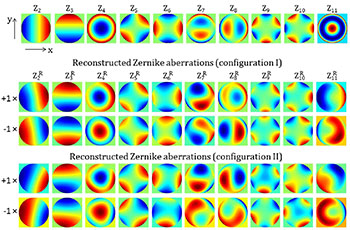
Known values of wavefront aberration for incident beam, plotted as circular Zernike polynomials (top), compared with the values reconstructed from reflected intensity distribution (“+1” line in bottom diagrams). The plots show good agreement except for spherical aberration (which is partly projected into the lower-order modes in the reconstruction). [Image: B. Vohnsen and D. Valente, Optica, doi: 10.1364/OPTICA.2.001024]
A two-scientist team has devised a method for using the intensity distribution of reflected light to sense and potentially reduce wavefront aberrations at the scale of nanometers (Optica, doi: 10.1364/OPTICA.2.001024). The team believes that the technique—which leverages plasmonics to achieve far denser wavefront sampling than is possible with conventional adaptive-optics (AO) techniques—could find use not only in typical AO settings but also in metrology, chemical sensing and other areas.
Sharpening up AO with surface plasmons
Wavefront sensing for AO and other applications commonly employs interferometric patterns or tightly grouped lenslet arrays. Both approaches have found wide use in AO for astronomy, microscopy and more. But both also sample only relatively coarse wavefront aberrations, on the scale of hundreds of microns. That limits AO’s ability to reduce distortions on finer scales.
To enable a sharper, higher-resolution view of wavefront aberrations that could lead to more refined AO, researchers Brian Vohnsen and Denise Valente of University College Dublin, Ireland, enlisted the help of surface plasmon polaritons (SPPs)—quasiparticles that arise from the coupling of photons and electron oscillations at a metal-air interface. SPPs are shorter in wavelength than the incident light, and thus offer the prospect of nanometer-scale sampling of the wavefront. Vohnsen and Valente reasoned that the behavior of SPPs, which varies depending on the angle of the incident light, could be used as a skeleton key to reconstruct the wavefront shape and, potentially, correct aberrations at nanometer scales.
Reflected light from gold foil
As a proof of concept, the researchers began by using a MEMS deformable mirror to create a wavefront with a specific, measurable aberration, and plotted the total aberration as a series of circular Zernike polynomials, a standard mathematical description of lens aberrations. They then shone the distorted wavefront on a strip of extremely smooth, 50-nm-thick gold foil atop a glass cover slip, at two orthogonal angles, and captured the reflected signal using an extremely sensitive CCD camera.
Next, using the signal from the CCD, the researchers calculated the difference between the measured reflectance and the expected values for a perfect planar reference wave. The variations in intensity from ideal values—attributable to nanometer-scale differences associated with SPP excitations—effectively gave the scientists the first spatial derivative of each of the Zernike modes describing the wavefront distortions. The team then simply numerically integrated these derivatives to reconstruct the original wavefront aberration, in good agreement with the actual known deformation that had been imposed by the deformable mirror.
While the system still has a few hurdles to clear, tied mainly to the specifics of the coherent light source and deformable mirror, the team believes that those are surmountable—and that the system will ultimately bring to bear significant advantages in speed and resolution. Corresponding author Vohnsen, quoted in a press release, suggested that the technique “enables new pathways for nanoscale sensitivity for a whole host of applications.”
